Organizational Behaviour & Management
VerifiedAdded on 2020/02/03
|13
|3923
|49
Literature Review
AI Summary
This assignment delves into various theories of organizational behavior, encompassing topics like motivation, power dynamics, leadership styles, and the impact of organizational structure on employee performance. It examines classic theories such as Maslow's Hierarchy of Needs, Herzberg's Two-Factor Theory, and McGregor's Theory X and Y. Additionally, it explores contemporary concepts like servant leadership and panarchy, highlighting their relevance in modern workplaces. The assignment encourages critical analysis of these theories and their practical implications for effective management.
Contribute Materials
Your contribution can guide someone’s learning journey. Share your
documents today.
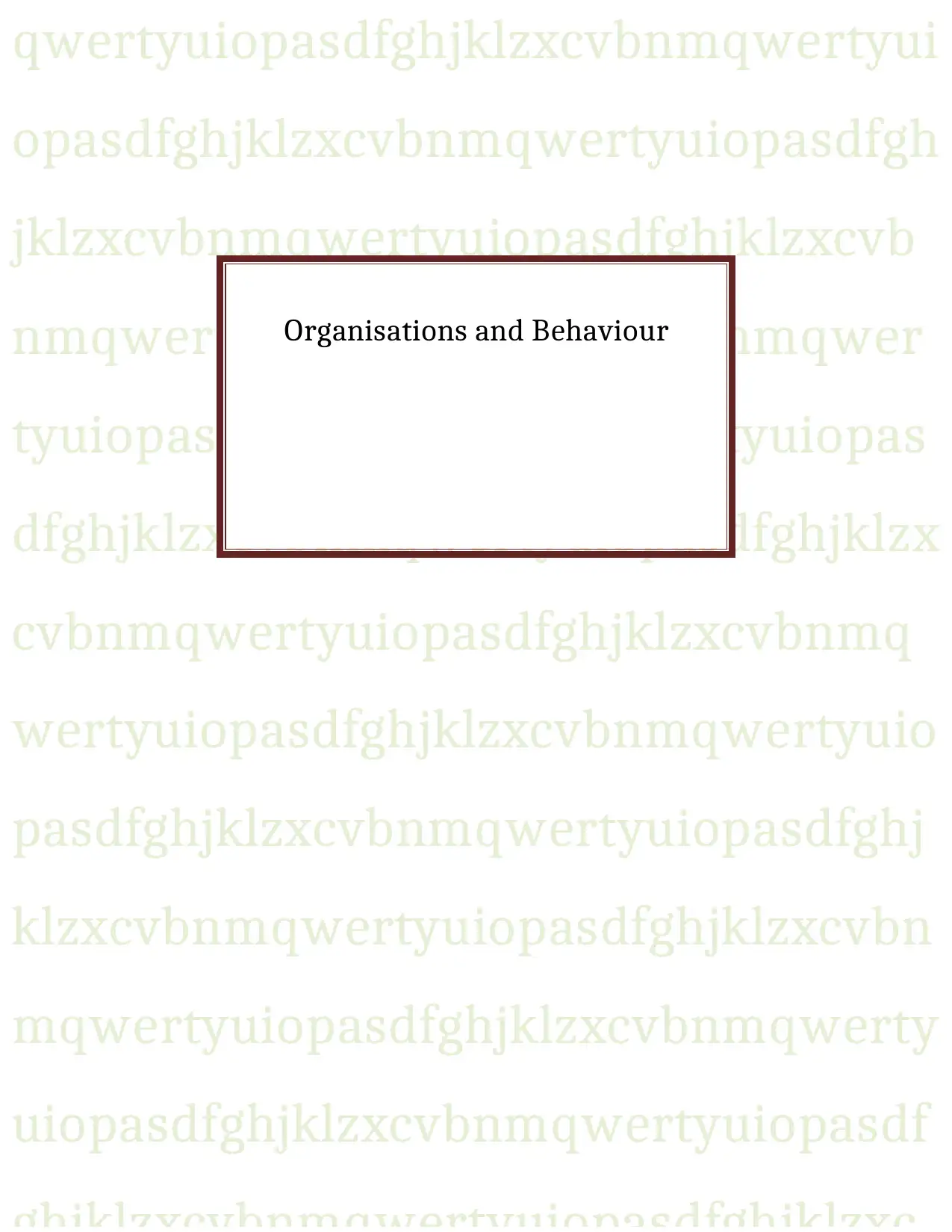
qwertyuiopasdfghjklzxcvbnmqwertyui
opasdfghjklzxcvbnmqwertyuiopasdfgh
jklzxcvbnmqwertyuiopasdfghjklzxcvb
nmqwertyuiopasdfghjklzxcvbnmqwer
tyuiopasdfghjklzxcvbnmqwertyuiopas
dfghjklzxcvbnmqwertyuiopasdfghjklzx
cvbnmqwertyuiopasdfghjklzxcvbnmq
wertyuiopasdfghjklzxcvbnmqwertyuio
pasdfghjklzxcvbnmqwertyuiopasdfghj
klzxcvbnmqwertyuiopasdfghjklzxcvbn
mqwertyuiopasdfghjklzxcvbnmqwerty
uiopasdfghjklzxcvbnmqwertyuiopasdf
Organisations and Behaviour
opasdfghjklzxcvbnmqwertyuiopasdfgh
jklzxcvbnmqwertyuiopasdfghjklzxcvb
nmqwertyuiopasdfghjklzxcvbnmqwer
tyuiopasdfghjklzxcvbnmqwertyuiopas
dfghjklzxcvbnmqwertyuiopasdfghjklzx
cvbnmqwertyuiopasdfghjklzxcvbnmq
wertyuiopasdfghjklzxcvbnmqwertyuio
pasdfghjklzxcvbnmqwertyuiopasdfghj
klzxcvbnmqwertyuiopasdfghjklzxcvbn
mqwertyuiopasdfghjklzxcvbnmqwerty
uiopasdfghjklzxcvbnmqwertyuiopasdf
Organisations and Behaviour
Secure Best Marks with AI Grader
Need help grading? Try our AI Grader for instant feedback on your assignments.
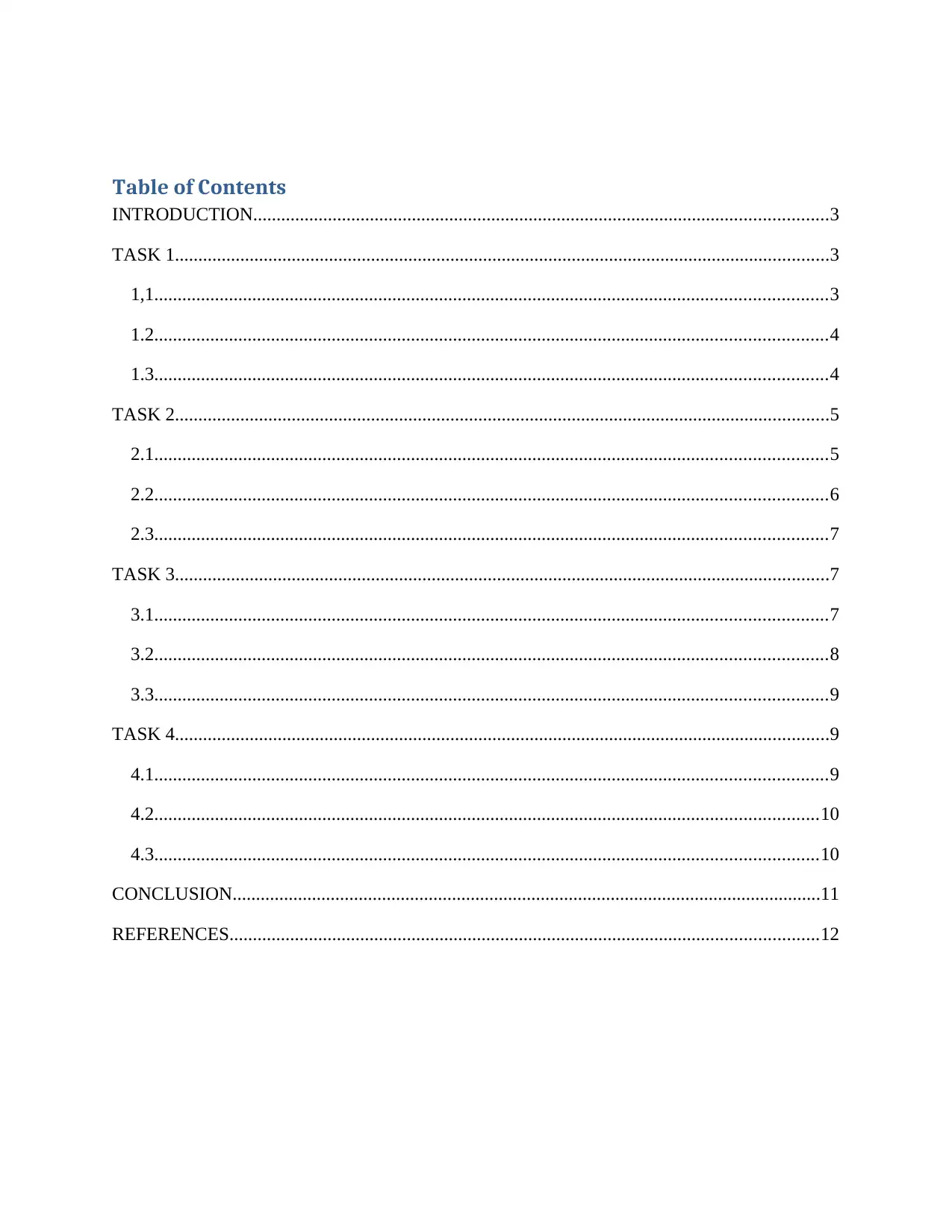
Table of Contents
INTRODUCTION...........................................................................................................................3
TASK 1............................................................................................................................................3
1,1................................................................................................................................................3
1.2................................................................................................................................................4
1.3................................................................................................................................................4
TASK 2............................................................................................................................................5
2.1................................................................................................................................................5
2.2................................................................................................................................................6
2.3................................................................................................................................................7
TASK 3............................................................................................................................................7
3.1................................................................................................................................................7
3.2................................................................................................................................................8
3.3................................................................................................................................................9
TASK 4............................................................................................................................................9
4.1................................................................................................................................................9
4.2..............................................................................................................................................10
4.3..............................................................................................................................................10
CONCLUSION..............................................................................................................................11
REFERENCES..............................................................................................................................12
INTRODUCTION...........................................................................................................................3
TASK 1............................................................................................................................................3
1,1................................................................................................................................................3
1.2................................................................................................................................................4
1.3................................................................................................................................................4
TASK 2............................................................................................................................................5
2.1................................................................................................................................................5
2.2................................................................................................................................................6
2.3................................................................................................................................................7
TASK 3............................................................................................................................................7
3.1................................................................................................................................................7
3.2................................................................................................................................................8
3.3................................................................................................................................................9
TASK 4............................................................................................................................................9
4.1................................................................................................................................................9
4.2..............................................................................................................................................10
4.3..............................................................................................................................................10
CONCLUSION..............................................................................................................................11
REFERENCES..............................................................................................................................12
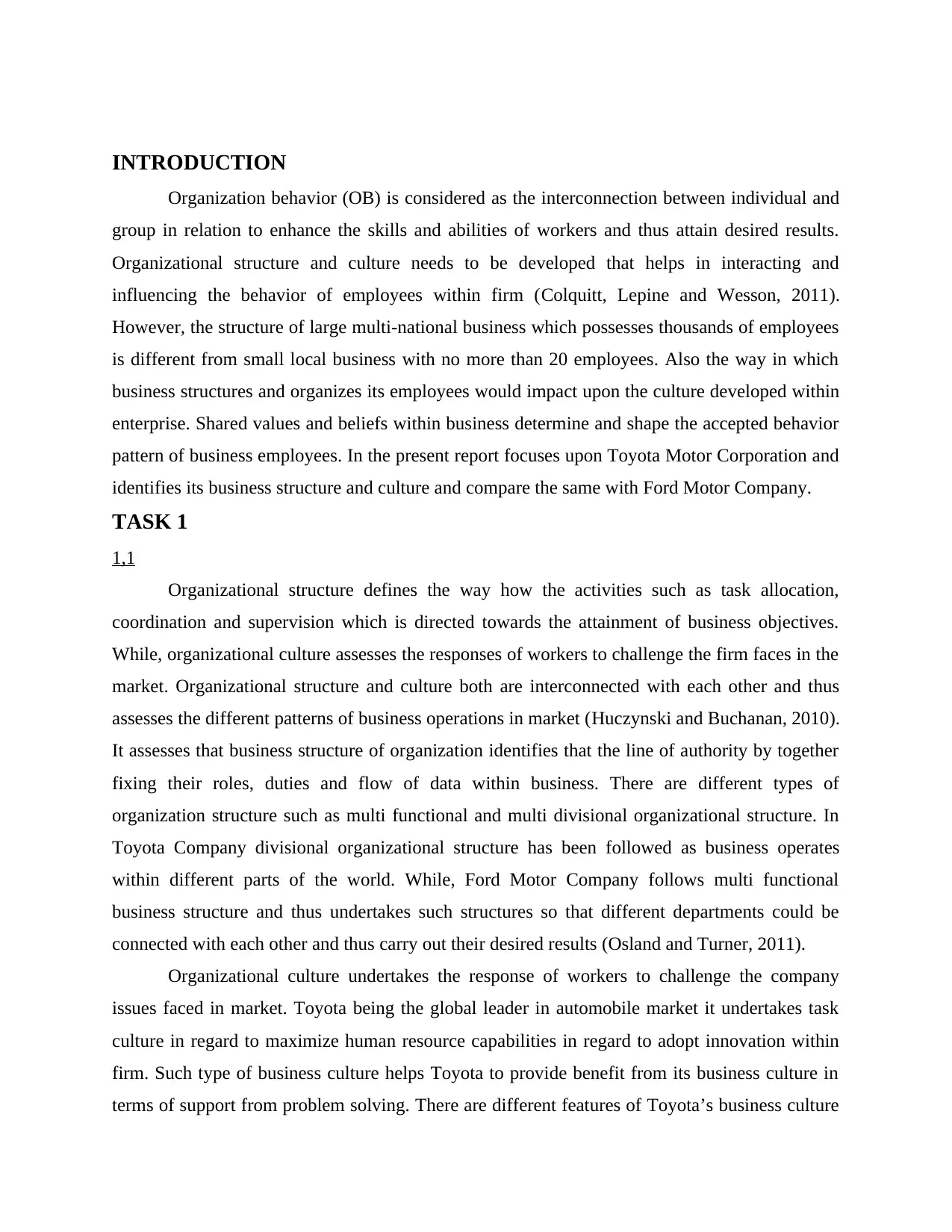
INTRODUCTION
Organization behavior (OB) is considered as the interconnection between individual and
group in relation to enhance the skills and abilities of workers and thus attain desired results.
Organizational structure and culture needs to be developed that helps in interacting and
influencing the behavior of employees within firm (Colquitt, Lepine and Wesson, 2011).
However, the structure of large multi-national business which possesses thousands of employees
is different from small local business with no more than 20 employees. Also the way in which
business structures and organizes its employees would impact upon the culture developed within
enterprise. Shared values and beliefs within business determine and shape the accepted behavior
pattern of business employees. In the present report focuses upon Toyota Motor Corporation and
identifies its business structure and culture and compare the same with Ford Motor Company.
TASK 1
1,1
Organizational structure defines the way how the activities such as task allocation,
coordination and supervision which is directed towards the attainment of business objectives.
While, organizational culture assesses the responses of workers to challenge the firm faces in the
market. Organizational structure and culture both are interconnected with each other and thus
assesses the different patterns of business operations in market (Huczynski and Buchanan, 2010).
It assesses that business structure of organization identifies that the line of authority by together
fixing their roles, duties and flow of data within business. There are different types of
organization structure such as multi functional and multi divisional organizational structure. In
Toyota Company divisional organizational structure has been followed as business operates
within different parts of the world. While, Ford Motor Company follows multi functional
business structure and thus undertakes such structures so that different departments could be
connected with each other and thus carry out their desired results (Osland and Turner, 2011).
Organizational culture undertakes the response of workers to challenge the company
issues faced in market. Toyota being the global leader in automobile market it undertakes task
culture in regard to maximize human resource capabilities in regard to adopt innovation within
firm. Such type of business culture helps Toyota to provide benefit from its business culture in
terms of support from problem solving. There are different features of Toyota’s business culture
Organization behavior (OB) is considered as the interconnection between individual and
group in relation to enhance the skills and abilities of workers and thus attain desired results.
Organizational structure and culture needs to be developed that helps in interacting and
influencing the behavior of employees within firm (Colquitt, Lepine and Wesson, 2011).
However, the structure of large multi-national business which possesses thousands of employees
is different from small local business with no more than 20 employees. Also the way in which
business structures and organizes its employees would impact upon the culture developed within
enterprise. Shared values and beliefs within business determine and shape the accepted behavior
pattern of business employees. In the present report focuses upon Toyota Motor Corporation and
identifies its business structure and culture and compare the same with Ford Motor Company.
TASK 1
1,1
Organizational structure defines the way how the activities such as task allocation,
coordination and supervision which is directed towards the attainment of business objectives.
While, organizational culture assesses the responses of workers to challenge the firm faces in the
market. Organizational structure and culture both are interconnected with each other and thus
assesses the different patterns of business operations in market (Huczynski and Buchanan, 2010).
It assesses that business structure of organization identifies that the line of authority by together
fixing their roles, duties and flow of data within business. There are different types of
organization structure such as multi functional and multi divisional organizational structure. In
Toyota Company divisional organizational structure has been followed as business operates
within different parts of the world. While, Ford Motor Company follows multi functional
business structure and thus undertakes such structures so that different departments could be
connected with each other and thus carry out their desired results (Osland and Turner, 2011).
Organizational culture undertakes the response of workers to challenge the company
issues faced in market. Toyota being the global leader in automobile market it undertakes task
culture in regard to maximize human resource capabilities in regard to adopt innovation within
firm. Such type of business culture helps Toyota to provide benefit from its business culture in
terms of support from problem solving. There are different features of Toyota’s business culture
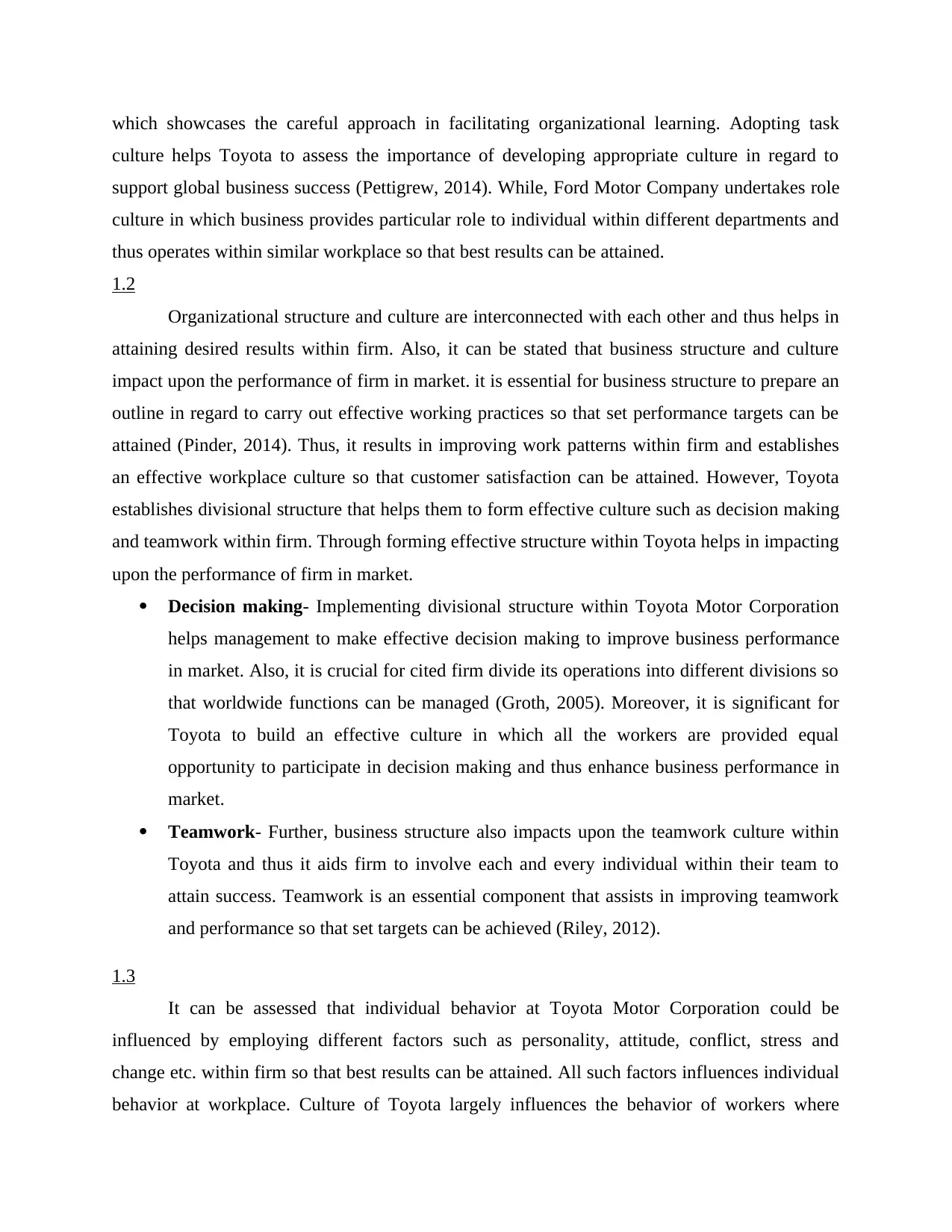
which showcases the careful approach in facilitating organizational learning. Adopting task
culture helps Toyota to assess the importance of developing appropriate culture in regard to
support global business success (Pettigrew, 2014). While, Ford Motor Company undertakes role
culture in which business provides particular role to individual within different departments and
thus operates within similar workplace so that best results can be attained.
1.2
Organizational structure and culture are interconnected with each other and thus helps in
attaining desired results within firm. Also, it can be stated that business structure and culture
impact upon the performance of firm in market. it is essential for business structure to prepare an
outline in regard to carry out effective working practices so that set performance targets can be
attained (Pinder, 2014). Thus, it results in improving work patterns within firm and establishes
an effective workplace culture so that customer satisfaction can be attained. However, Toyota
establishes divisional structure that helps them to form effective culture such as decision making
and teamwork within firm. Through forming effective structure within Toyota helps in impacting
upon the performance of firm in market.
Decision making- Implementing divisional structure within Toyota Motor Corporation
helps management to make effective decision making to improve business performance
in market. Also, it is crucial for cited firm divide its operations into different divisions so
that worldwide functions can be managed (Groth, 2005). Moreover, it is significant for
Toyota to build an effective culture in which all the workers are provided equal
opportunity to participate in decision making and thus enhance business performance in
market.
Teamwork- Further, business structure also impacts upon the teamwork culture within
Toyota and thus it aids firm to involve each and every individual within their team to
attain success. Teamwork is an essential component that assists in improving teamwork
and performance so that set targets can be achieved (Riley, 2012).
1.3
It can be assessed that individual behavior at Toyota Motor Corporation could be
influenced by employing different factors such as personality, attitude, conflict, stress and
change etc. within firm so that best results can be attained. All such factors influences individual
behavior at workplace. Culture of Toyota largely influences the behavior of workers where
culture helps Toyota to assess the importance of developing appropriate culture in regard to
support global business success (Pettigrew, 2014). While, Ford Motor Company undertakes role
culture in which business provides particular role to individual within different departments and
thus operates within similar workplace so that best results can be attained.
1.2
Organizational structure and culture are interconnected with each other and thus helps in
attaining desired results within firm. Also, it can be stated that business structure and culture
impact upon the performance of firm in market. it is essential for business structure to prepare an
outline in regard to carry out effective working practices so that set performance targets can be
attained (Pinder, 2014). Thus, it results in improving work patterns within firm and establishes
an effective workplace culture so that customer satisfaction can be attained. However, Toyota
establishes divisional structure that helps them to form effective culture such as decision making
and teamwork within firm. Through forming effective structure within Toyota helps in impacting
upon the performance of firm in market.
Decision making- Implementing divisional structure within Toyota Motor Corporation
helps management to make effective decision making to improve business performance
in market. Also, it is crucial for cited firm divide its operations into different divisions so
that worldwide functions can be managed (Groth, 2005). Moreover, it is significant for
Toyota to build an effective culture in which all the workers are provided equal
opportunity to participate in decision making and thus enhance business performance in
market.
Teamwork- Further, business structure also impacts upon the teamwork culture within
Toyota and thus it aids firm to involve each and every individual within their team to
attain success. Teamwork is an essential component that assists in improving teamwork
and performance so that set targets can be achieved (Riley, 2012).
1.3
It can be assessed that individual behavior at Toyota Motor Corporation could be
influenced by employing different factors such as personality, attitude, conflict, stress and
change etc. within firm so that best results can be attained. All such factors influences individual
behavior at workplace. Culture of Toyota largely influences the behavior of workers where
Secure Best Marks with AI Grader
Need help grading? Try our AI Grader for instant feedback on your assignments.
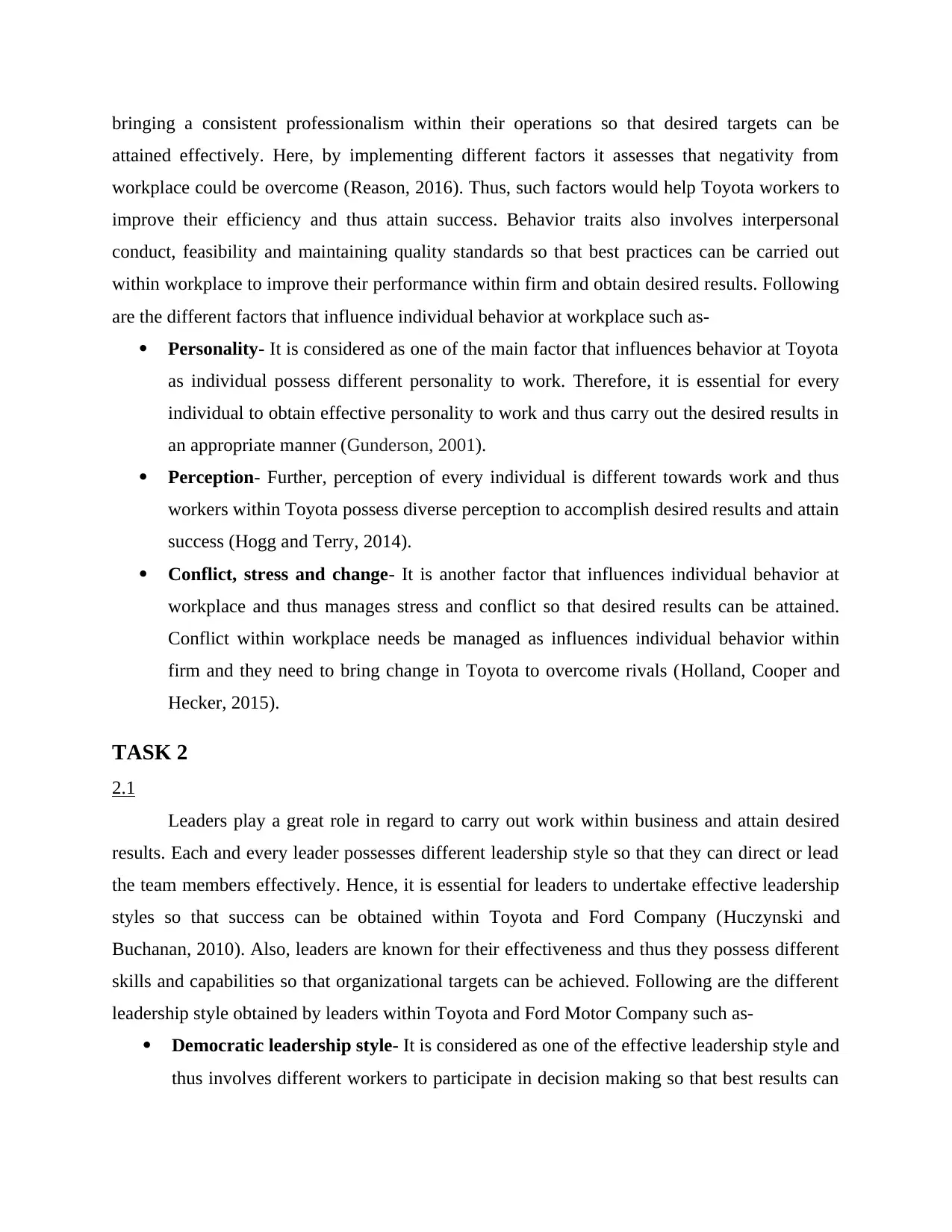
bringing a consistent professionalism within their operations so that desired targets can be
attained effectively. Here, by implementing different factors it assesses that negativity from
workplace could be overcome (Reason, 2016). Thus, such factors would help Toyota workers to
improve their efficiency and thus attain success. Behavior traits also involves interpersonal
conduct, feasibility and maintaining quality standards so that best practices can be carried out
within workplace to improve their performance within firm and obtain desired results. Following
are the different factors that influence individual behavior at workplace such as-
Personality- It is considered as one of the main factor that influences behavior at Toyota
as individual possess different personality to work. Therefore, it is essential for every
individual to obtain effective personality to work and thus carry out the desired results in
an appropriate manner (Gunderson, 2001).
Perception- Further, perception of every individual is different towards work and thus
workers within Toyota possess diverse perception to accomplish desired results and attain
success (Hogg and Terry, 2014).
Conflict, stress and change- It is another factor that influences individual behavior at
workplace and thus manages stress and conflict so that desired results can be attained.
Conflict within workplace needs be managed as influences individual behavior within
firm and they need to bring change in Toyota to overcome rivals (Holland, Cooper and
Hecker, 2015).
TASK 2
2.1
Leaders play a great role in regard to carry out work within business and attain desired
results. Each and every leader possesses different leadership style so that they can direct or lead
the team members effectively. Hence, it is essential for leaders to undertake effective leadership
styles so that success can be obtained within Toyota and Ford Company (Huczynski and
Buchanan, 2010). Also, leaders are known for their effectiveness and thus they possess different
skills and capabilities so that organizational targets can be achieved. Following are the different
leadership style obtained by leaders within Toyota and Ford Motor Company such as-
Democratic leadership style- It is considered as one of the effective leadership style and
thus involves different workers to participate in decision making so that best results can
attained effectively. Here, by implementing different factors it assesses that negativity from
workplace could be overcome (Reason, 2016). Thus, such factors would help Toyota workers to
improve their efficiency and thus attain success. Behavior traits also involves interpersonal
conduct, feasibility and maintaining quality standards so that best practices can be carried out
within workplace to improve their performance within firm and obtain desired results. Following
are the different factors that influence individual behavior at workplace such as-
Personality- It is considered as one of the main factor that influences behavior at Toyota
as individual possess different personality to work. Therefore, it is essential for every
individual to obtain effective personality to work and thus carry out the desired results in
an appropriate manner (Gunderson, 2001).
Perception- Further, perception of every individual is different towards work and thus
workers within Toyota possess diverse perception to accomplish desired results and attain
success (Hogg and Terry, 2014).
Conflict, stress and change- It is another factor that influences individual behavior at
workplace and thus manages stress and conflict so that desired results can be attained.
Conflict within workplace needs be managed as influences individual behavior within
firm and they need to bring change in Toyota to overcome rivals (Holland, Cooper and
Hecker, 2015).
TASK 2
2.1
Leaders play a great role in regard to carry out work within business and attain desired
results. Each and every leader possesses different leadership style so that they can direct or lead
the team members effectively. Hence, it is essential for leaders to undertake effective leadership
styles so that success can be obtained within Toyota and Ford Company (Huczynski and
Buchanan, 2010). Also, leaders are known for their effectiveness and thus they possess different
skills and capabilities so that organizational targets can be achieved. Following are the different
leadership style obtained by leaders within Toyota and Ford Motor Company such as-
Democratic leadership style- It is considered as one of the effective leadership style and
thus involves different workers to participate in decision making so that best results can
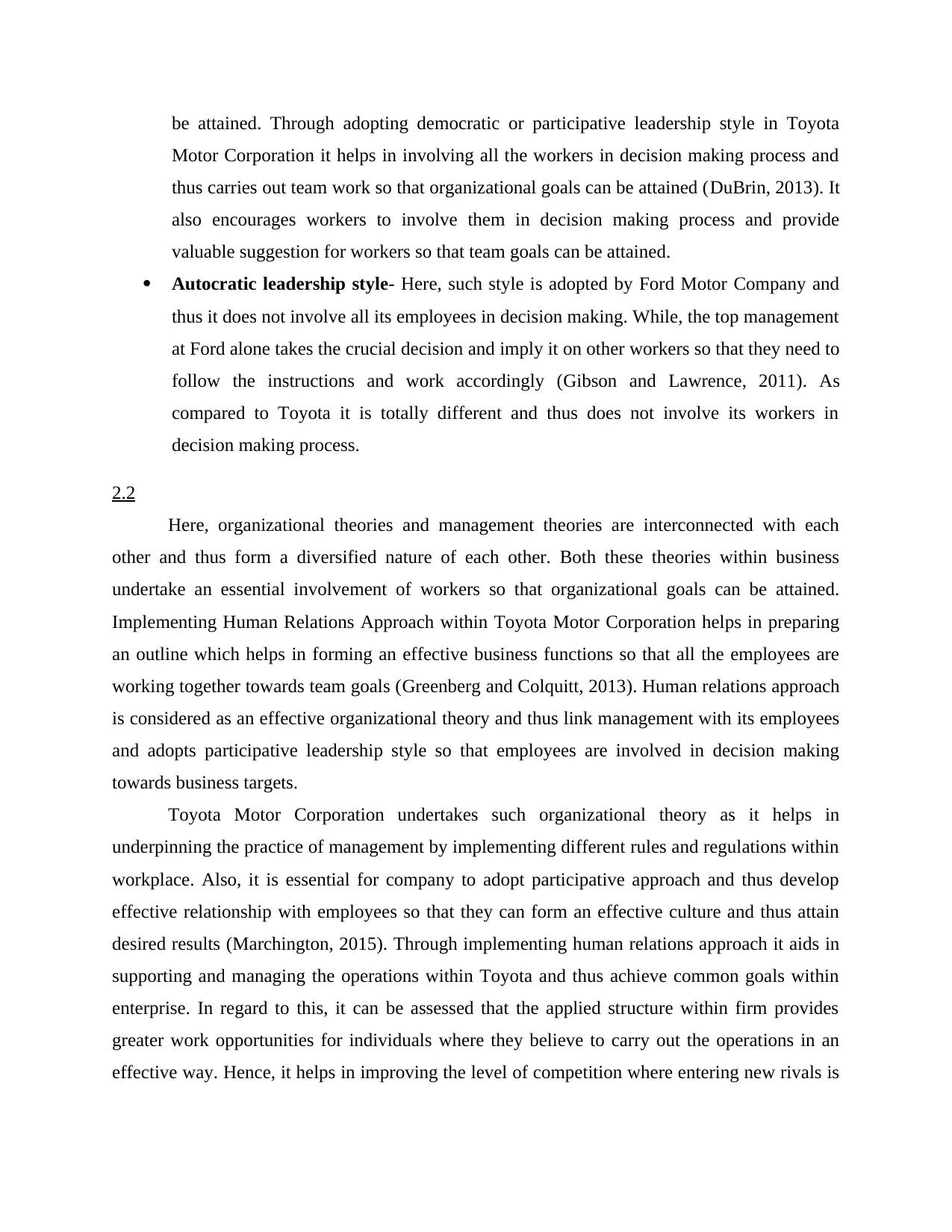
be attained. Through adopting democratic or participative leadership style in Toyota
Motor Corporation it helps in involving all the workers in decision making process and
thus carries out team work so that organizational goals can be attained (DuBrin, 2013). It
also encourages workers to involve them in decision making process and provide
valuable suggestion for workers so that team goals can be attained.
Autocratic leadership style- Here, such style is adopted by Ford Motor Company and
thus it does not involve all its employees in decision making. While, the top management
at Ford alone takes the crucial decision and imply it on other workers so that they need to
follow the instructions and work accordingly (Gibson and Lawrence, 2011). As
compared to Toyota it is totally different and thus does not involve its workers in
decision making process.
2.2
Here, organizational theories and management theories are interconnected with each
other and thus form a diversified nature of each other. Both these theories within business
undertake an essential involvement of workers so that organizational goals can be attained.
Implementing Human Relations Approach within Toyota Motor Corporation helps in preparing
an outline which helps in forming an effective business functions so that all the employees are
working together towards team goals (Greenberg and Colquitt, 2013). Human relations approach
is considered as an effective organizational theory and thus link management with its employees
and adopts participative leadership style so that employees are involved in decision making
towards business targets.
Toyota Motor Corporation undertakes such organizational theory as it helps in
underpinning the practice of management by implementing different rules and regulations within
workplace. Also, it is essential for company to adopt participative approach and thus develop
effective relationship with employees so that they can form an effective culture and thus attain
desired results (Marchington, 2015). Through implementing human relations approach it aids in
supporting and managing the operations within Toyota and thus achieve common goals within
enterprise. In regard to this, it can be assessed that the applied structure within firm provides
greater work opportunities for individuals where they believe to carry out the operations in an
effective way. Hence, it helps in improving the level of competition where entering new rivals is
Motor Corporation it helps in involving all the workers in decision making process and
thus carries out team work so that organizational goals can be attained (DuBrin, 2013). It
also encourages workers to involve them in decision making process and provide
valuable suggestion for workers so that team goals can be attained.
Autocratic leadership style- Here, such style is adopted by Ford Motor Company and
thus it does not involve all its employees in decision making. While, the top management
at Ford alone takes the crucial decision and imply it on other workers so that they need to
follow the instructions and work accordingly (Gibson and Lawrence, 2011). As
compared to Toyota it is totally different and thus does not involve its workers in
decision making process.
2.2
Here, organizational theories and management theories are interconnected with each
other and thus form a diversified nature of each other. Both these theories within business
undertake an essential involvement of workers so that organizational goals can be attained.
Implementing Human Relations Approach within Toyota Motor Corporation helps in preparing
an outline which helps in forming an effective business functions so that all the employees are
working together towards team goals (Greenberg and Colquitt, 2013). Human relations approach
is considered as an effective organizational theory and thus link management with its employees
and adopts participative leadership style so that employees are involved in decision making
towards business targets.
Toyota Motor Corporation undertakes such organizational theory as it helps in
underpinning the practice of management by implementing different rules and regulations within
workplace. Also, it is essential for company to adopt participative approach and thus develop
effective relationship with employees so that they can form an effective culture and thus attain
desired results (Marchington, 2015). Through implementing human relations approach it aids in
supporting and managing the operations within Toyota and thus achieve common goals within
enterprise. In regard to this, it can be assessed that the applied structure within firm provides
greater work opportunities for individuals where they believe to carry out the operations in an
effective way. Hence, it helps in improving the level of competition where entering new rivals is
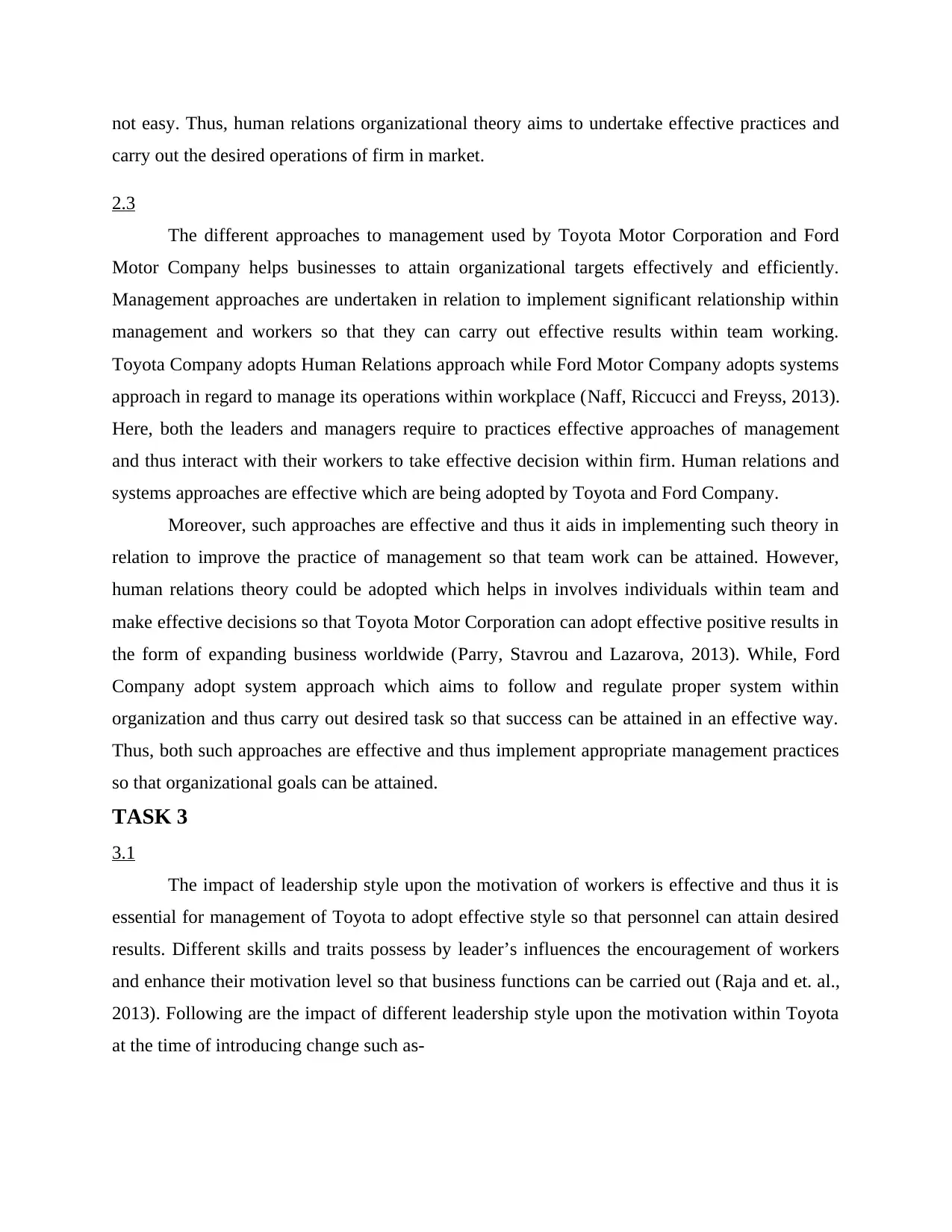
not easy. Thus, human relations organizational theory aims to undertake effective practices and
carry out the desired operations of firm in market.
2.3
The different approaches to management used by Toyota Motor Corporation and Ford
Motor Company helps businesses to attain organizational targets effectively and efficiently.
Management approaches are undertaken in relation to implement significant relationship within
management and workers so that they can carry out effective results within team working.
Toyota Company adopts Human Relations approach while Ford Motor Company adopts systems
approach in regard to manage its operations within workplace (Naff, Riccucci and Freyss, 2013).
Here, both the leaders and managers require to practices effective approaches of management
and thus interact with their workers to take effective decision within firm. Human relations and
systems approaches are effective which are being adopted by Toyota and Ford Company.
Moreover, such approaches are effective and thus it aids in implementing such theory in
relation to improve the practice of management so that team work can be attained. However,
human relations theory could be adopted which helps in involves individuals within team and
make effective decisions so that Toyota Motor Corporation can adopt effective positive results in
the form of expanding business worldwide (Parry, Stavrou and Lazarova, 2013). While, Ford
Company adopt system approach which aims to follow and regulate proper system within
organization and thus carry out desired task so that success can be attained in an effective way.
Thus, both such approaches are effective and thus implement appropriate management practices
so that organizational goals can be attained.
TASK 3
3.1
The impact of leadership style upon the motivation of workers is effective and thus it is
essential for management of Toyota to adopt effective style so that personnel can attain desired
results. Different skills and traits possess by leader’s influences the encouragement of workers
and enhance their motivation level so that business functions can be carried out (Raja and et. al.,
2013). Following are the impact of different leadership style upon the motivation within Toyota
at the time of introducing change such as-
carry out the desired operations of firm in market.
2.3
The different approaches to management used by Toyota Motor Corporation and Ford
Motor Company helps businesses to attain organizational targets effectively and efficiently.
Management approaches are undertaken in relation to implement significant relationship within
management and workers so that they can carry out effective results within team working.
Toyota Company adopts Human Relations approach while Ford Motor Company adopts systems
approach in regard to manage its operations within workplace (Naff, Riccucci and Freyss, 2013).
Here, both the leaders and managers require to practices effective approaches of management
and thus interact with their workers to take effective decision within firm. Human relations and
systems approaches are effective which are being adopted by Toyota and Ford Company.
Moreover, such approaches are effective and thus it aids in implementing such theory in
relation to improve the practice of management so that team work can be attained. However,
human relations theory could be adopted which helps in involves individuals within team and
make effective decisions so that Toyota Motor Corporation can adopt effective positive results in
the form of expanding business worldwide (Parry, Stavrou and Lazarova, 2013). While, Ford
Company adopt system approach which aims to follow and regulate proper system within
organization and thus carry out desired task so that success can be attained in an effective way.
Thus, both such approaches are effective and thus implement appropriate management practices
so that organizational goals can be attained.
TASK 3
3.1
The impact of leadership style upon the motivation of workers is effective and thus it is
essential for management of Toyota to adopt effective style so that personnel can attain desired
results. Different skills and traits possess by leader’s influences the encouragement of workers
and enhance their motivation level so that business functions can be carried out (Raja and et. al.,
2013). Following are the impact of different leadership style upon the motivation within Toyota
at the time of introducing change such as-
Paraphrase This Document
Need a fresh take? Get an instant paraphrase of this document with our AI Paraphraser
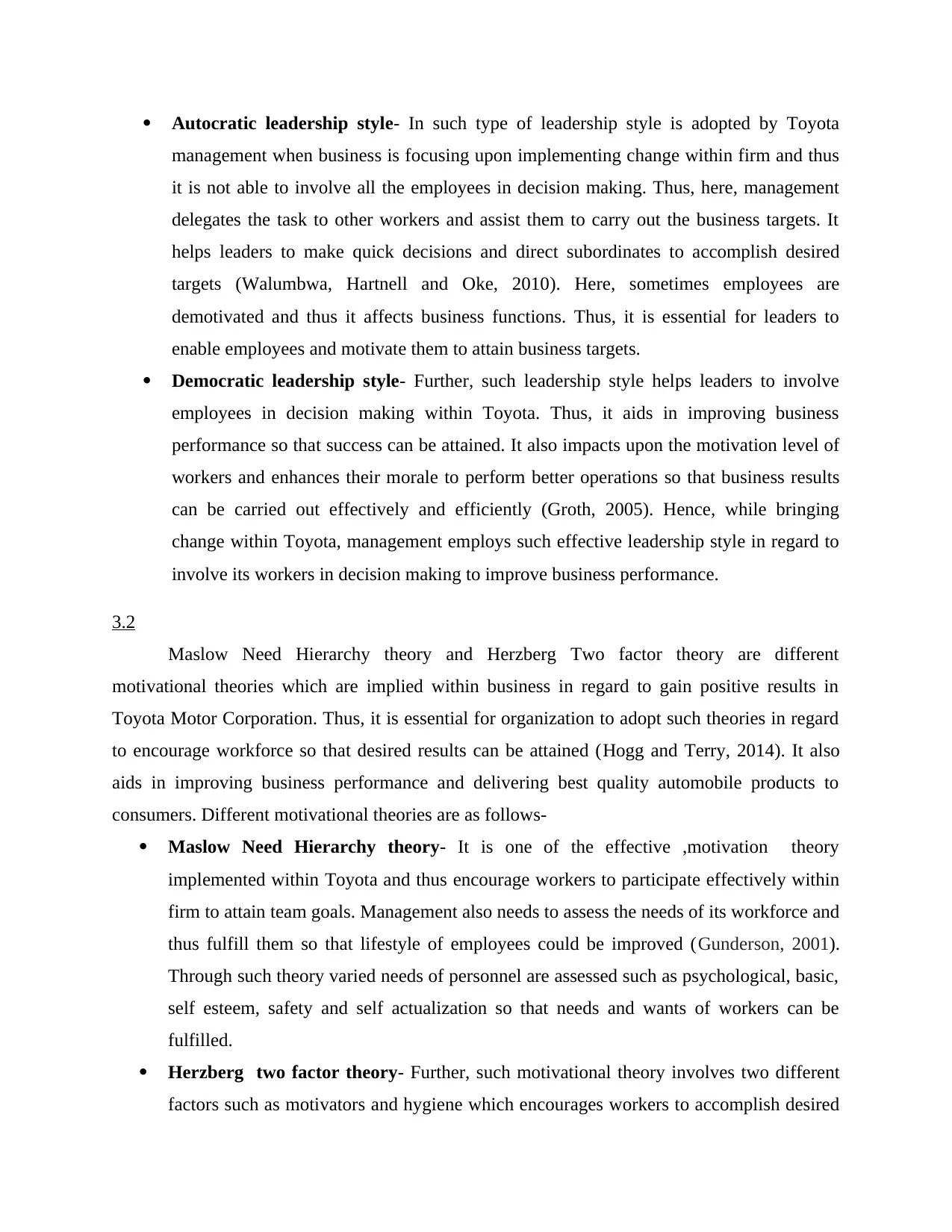
Autocratic leadership style- In such type of leadership style is adopted by Toyota
management when business is focusing upon implementing change within firm and thus
it is not able to involve all the employees in decision making. Thus, here, management
delegates the task to other workers and assist them to carry out the business targets. It
helps leaders to make quick decisions and direct subordinates to accomplish desired
targets (Walumbwa, Hartnell and Oke, 2010). Here, sometimes employees are
demotivated and thus it affects business functions. Thus, it is essential for leaders to
enable employees and motivate them to attain business targets.
Democratic leadership style- Further, such leadership style helps leaders to involve
employees in decision making within Toyota. Thus, it aids in improving business
performance so that success can be attained. It also impacts upon the motivation level of
workers and enhances their morale to perform better operations so that business results
can be carried out effectively and efficiently (Groth, 2005). Hence, while bringing
change within Toyota, management employs such effective leadership style in regard to
involve its workers in decision making to improve business performance.
3.2
Maslow Need Hierarchy theory and Herzberg Two factor theory are different
motivational theories which are implied within business in regard to gain positive results in
Toyota Motor Corporation. Thus, it is essential for organization to adopt such theories in regard
to encourage workforce so that desired results can be attained (Hogg and Terry, 2014). It also
aids in improving business performance and delivering best quality automobile products to
consumers. Different motivational theories are as follows-
Maslow Need Hierarchy theory- It is one of the effective ,motivation theory
implemented within Toyota and thus encourage workers to participate effectively within
firm to attain team goals. Management also needs to assess the needs of its workforce and
thus fulfill them so that lifestyle of employees could be improved (Gunderson, 2001).
Through such theory varied needs of personnel are assessed such as psychological, basic,
self esteem, safety and self actualization so that needs and wants of workers can be
fulfilled.
Herzberg two factor theory- Further, such motivational theory involves two different
factors such as motivators and hygiene which encourages workers to accomplish desired
management when business is focusing upon implementing change within firm and thus
it is not able to involve all the employees in decision making. Thus, here, management
delegates the task to other workers and assist them to carry out the business targets. It
helps leaders to make quick decisions and direct subordinates to accomplish desired
targets (Walumbwa, Hartnell and Oke, 2010). Here, sometimes employees are
demotivated and thus it affects business functions. Thus, it is essential for leaders to
enable employees and motivate them to attain business targets.
Democratic leadership style- Further, such leadership style helps leaders to involve
employees in decision making within Toyota. Thus, it aids in improving business
performance so that success can be attained. It also impacts upon the motivation level of
workers and enhances their morale to perform better operations so that business results
can be carried out effectively and efficiently (Groth, 2005). Hence, while bringing
change within Toyota, management employs such effective leadership style in regard to
involve its workers in decision making to improve business performance.
3.2
Maslow Need Hierarchy theory and Herzberg Two factor theory are different
motivational theories which are implied within business in regard to gain positive results in
Toyota Motor Corporation. Thus, it is essential for organization to adopt such theories in regard
to encourage workforce so that desired results can be attained (Hogg and Terry, 2014). It also
aids in improving business performance and delivering best quality automobile products to
consumers. Different motivational theories are as follows-
Maslow Need Hierarchy theory- It is one of the effective ,motivation theory
implemented within Toyota and thus encourage workers to participate effectively within
firm to attain team goals. Management also needs to assess the needs of its workforce and
thus fulfill them so that lifestyle of employees could be improved (Gunderson, 2001).
Through such theory varied needs of personnel are assessed such as psychological, basic,
self esteem, safety and self actualization so that needs and wants of workers can be
fulfilled.
Herzberg two factor theory- Further, such motivational theory involves two different
factors such as motivators and hygiene which encourages workers to accomplish desired
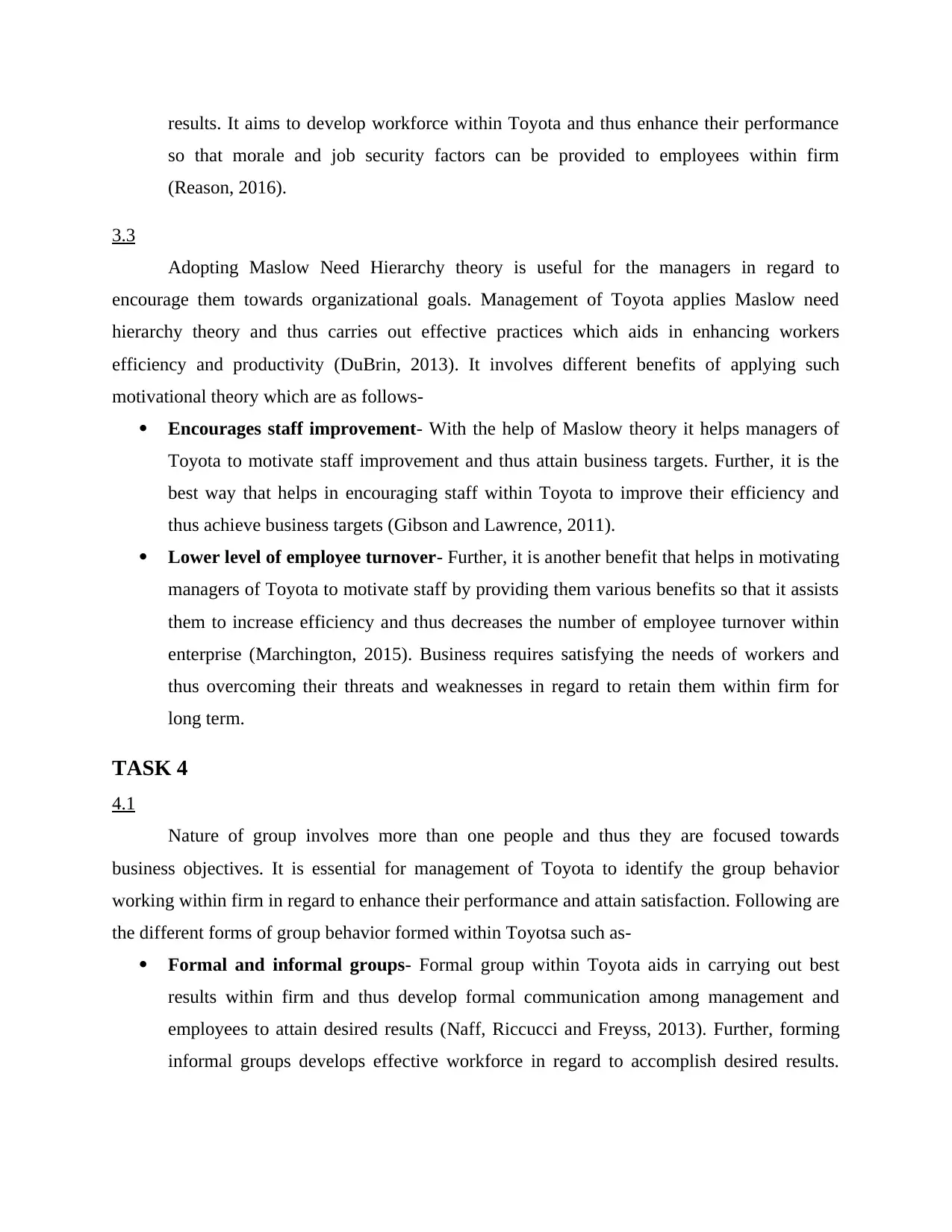
results. It aims to develop workforce within Toyota and thus enhance their performance
so that morale and job security factors can be provided to employees within firm
(Reason, 2016).
3.3
Adopting Maslow Need Hierarchy theory is useful for the managers in regard to
encourage them towards organizational goals. Management of Toyota applies Maslow need
hierarchy theory and thus carries out effective practices which aids in enhancing workers
efficiency and productivity (DuBrin, 2013). It involves different benefits of applying such
motivational theory which are as follows-
Encourages staff improvement- With the help of Maslow theory it helps managers of
Toyota to motivate staff improvement and thus attain business targets. Further, it is the
best way that helps in encouraging staff within Toyota to improve their efficiency and
thus achieve business targets (Gibson and Lawrence, 2011).
Lower level of employee turnover- Further, it is another benefit that helps in motivating
managers of Toyota to motivate staff by providing them various benefits so that it assists
them to increase efficiency and thus decreases the number of employee turnover within
enterprise (Marchington, 2015). Business requires satisfying the needs of workers and
thus overcoming their threats and weaknesses in regard to retain them within firm for
long term.
TASK 4
4.1
Nature of group involves more than one people and thus they are focused towards
business objectives. It is essential for management of Toyota to identify the group behavior
working within firm in regard to enhance their performance and attain satisfaction. Following are
the different forms of group behavior formed within Toyotsa such as-
Formal and informal groups- Formal group within Toyota aids in carrying out best
results within firm and thus develop formal communication among management and
employees to attain desired results (Naff, Riccucci and Freyss, 2013). Further, forming
informal groups develops effective workforce in regard to accomplish desired results.
so that morale and job security factors can be provided to employees within firm
(Reason, 2016).
3.3
Adopting Maslow Need Hierarchy theory is useful for the managers in regard to
encourage them towards organizational goals. Management of Toyota applies Maslow need
hierarchy theory and thus carries out effective practices which aids in enhancing workers
efficiency and productivity (DuBrin, 2013). It involves different benefits of applying such
motivational theory which are as follows-
Encourages staff improvement- With the help of Maslow theory it helps managers of
Toyota to motivate staff improvement and thus attain business targets. Further, it is the
best way that helps in encouraging staff within Toyota to improve their efficiency and
thus achieve business targets (Gibson and Lawrence, 2011).
Lower level of employee turnover- Further, it is another benefit that helps in motivating
managers of Toyota to motivate staff by providing them various benefits so that it assists
them to increase efficiency and thus decreases the number of employee turnover within
enterprise (Marchington, 2015). Business requires satisfying the needs of workers and
thus overcoming their threats and weaknesses in regard to retain them within firm for
long term.
TASK 4
4.1
Nature of group involves more than one people and thus they are focused towards
business objectives. It is essential for management of Toyota to identify the group behavior
working within firm in regard to enhance their performance and attain satisfaction. Following are
the different forms of group behavior formed within Toyotsa such as-
Formal and informal groups- Formal group within Toyota aids in carrying out best
results within firm and thus develop formal communication among management and
employees to attain desired results (Naff, Riccucci and Freyss, 2013). Further, forming
informal groups develops effective workforce in regard to accomplish desired results.
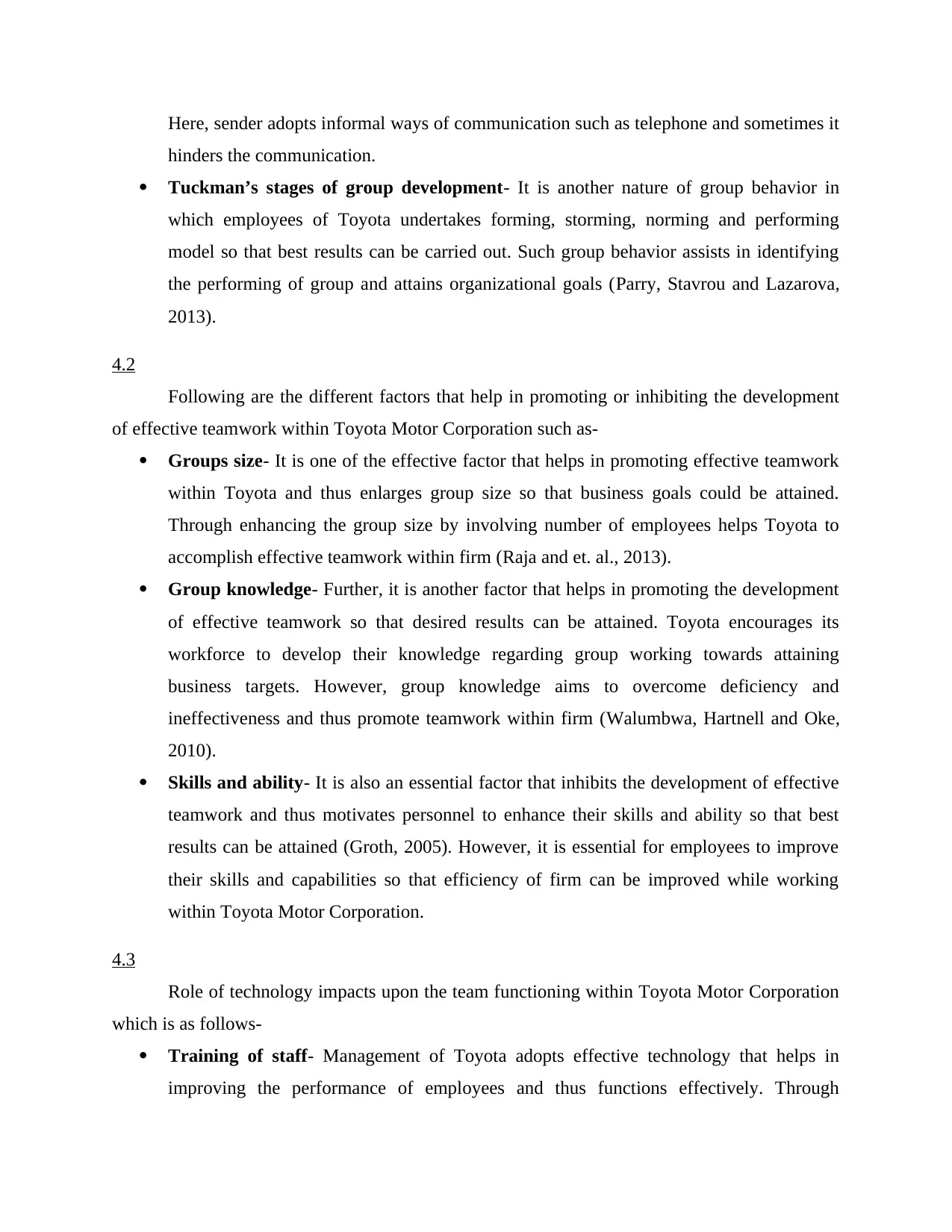
Here, sender adopts informal ways of communication such as telephone and sometimes it
hinders the communication.
Tuckman’s stages of group development- It is another nature of group behavior in
which employees of Toyota undertakes forming, storming, norming and performing
model so that best results can be carried out. Such group behavior assists in identifying
the performing of group and attains organizational goals (Parry, Stavrou and Lazarova,
2013).
4.2
Following are the different factors that help in promoting or inhibiting the development
of effective teamwork within Toyota Motor Corporation such as-
Groups size- It is one of the effective factor that helps in promoting effective teamwork
within Toyota and thus enlarges group size so that business goals could be attained.
Through enhancing the group size by involving number of employees helps Toyota to
accomplish effective teamwork within firm (Raja and et. al., 2013).
Group knowledge- Further, it is another factor that helps in promoting the development
of effective teamwork so that desired results can be attained. Toyota encourages its
workforce to develop their knowledge regarding group working towards attaining
business targets. However, group knowledge aims to overcome deficiency and
ineffectiveness and thus promote teamwork within firm (Walumbwa, Hartnell and Oke,
2010).
Skills and ability- It is also an essential factor that inhibits the development of effective
teamwork and thus motivates personnel to enhance their skills and ability so that best
results can be attained (Groth, 2005). However, it is essential for employees to improve
their skills and capabilities so that efficiency of firm can be improved while working
within Toyota Motor Corporation.
4.3
Role of technology impacts upon the team functioning within Toyota Motor Corporation
which is as follows-
Training of staff- Management of Toyota adopts effective technology that helps in
improving the performance of employees and thus functions effectively. Through
hinders the communication.
Tuckman’s stages of group development- It is another nature of group behavior in
which employees of Toyota undertakes forming, storming, norming and performing
model so that best results can be carried out. Such group behavior assists in identifying
the performing of group and attains organizational goals (Parry, Stavrou and Lazarova,
2013).
4.2
Following are the different factors that help in promoting or inhibiting the development
of effective teamwork within Toyota Motor Corporation such as-
Groups size- It is one of the effective factor that helps in promoting effective teamwork
within Toyota and thus enlarges group size so that business goals could be attained.
Through enhancing the group size by involving number of employees helps Toyota to
accomplish effective teamwork within firm (Raja and et. al., 2013).
Group knowledge- Further, it is another factor that helps in promoting the development
of effective teamwork so that desired results can be attained. Toyota encourages its
workforce to develop their knowledge regarding group working towards attaining
business targets. However, group knowledge aims to overcome deficiency and
ineffectiveness and thus promote teamwork within firm (Walumbwa, Hartnell and Oke,
2010).
Skills and ability- It is also an essential factor that inhibits the development of effective
teamwork and thus motivates personnel to enhance their skills and ability so that best
results can be attained (Groth, 2005). However, it is essential for employees to improve
their skills and capabilities so that efficiency of firm can be improved while working
within Toyota Motor Corporation.
4.3
Role of technology impacts upon the team functioning within Toyota Motor Corporation
which is as follows-
Training of staff- Management of Toyota adopts effective technology that helps in
improving the performance of employees and thus functions effectively. Through
Secure Best Marks with AI Grader
Need help grading? Try our AI Grader for instant feedback on your assignments.
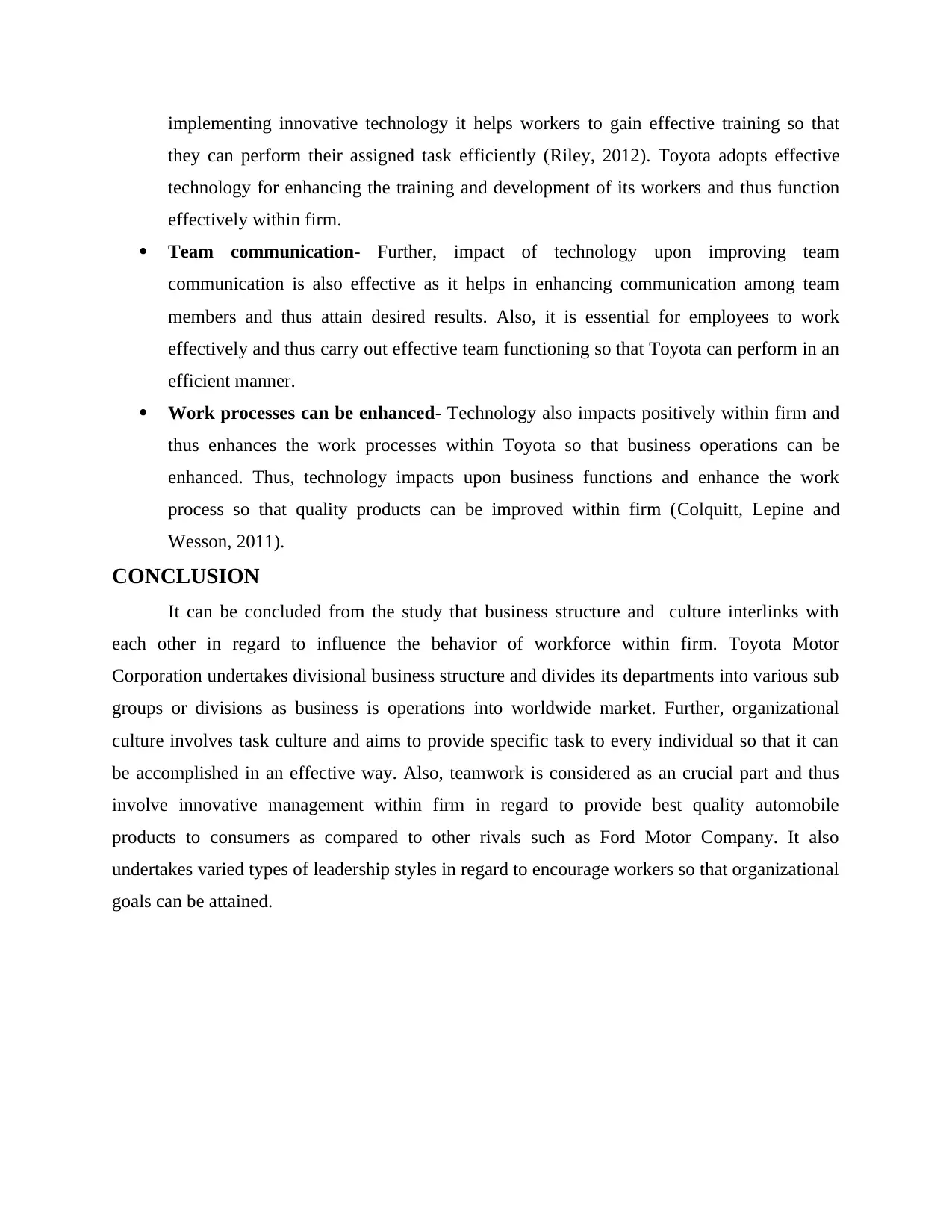
implementing innovative technology it helps workers to gain effective training so that
they can perform their assigned task efficiently (Riley, 2012). Toyota adopts effective
technology for enhancing the training and development of its workers and thus function
effectively within firm.
Team communication- Further, impact of technology upon improving team
communication is also effective as it helps in enhancing communication among team
members and thus attain desired results. Also, it is essential for employees to work
effectively and thus carry out effective team functioning so that Toyota can perform in an
efficient manner.
Work processes can be enhanced- Technology also impacts positively within firm and
thus enhances the work processes within Toyota so that business operations can be
enhanced. Thus, technology impacts upon business functions and enhance the work
process so that quality products can be improved within firm (Colquitt, Lepine and
Wesson, 2011).
CONCLUSION
It can be concluded from the study that business structure and culture interlinks with
each other in regard to influence the behavior of workforce within firm. Toyota Motor
Corporation undertakes divisional business structure and divides its departments into various sub
groups or divisions as business is operations into worldwide market. Further, organizational
culture involves task culture and aims to provide specific task to every individual so that it can
be accomplished in an effective way. Also, teamwork is considered as an crucial part and thus
involve innovative management within firm in regard to provide best quality automobile
products to consumers as compared to other rivals such as Ford Motor Company. It also
undertakes varied types of leadership styles in regard to encourage workers so that organizational
goals can be attained.
they can perform their assigned task efficiently (Riley, 2012). Toyota adopts effective
technology for enhancing the training and development of its workers and thus function
effectively within firm.
Team communication- Further, impact of technology upon improving team
communication is also effective as it helps in enhancing communication among team
members and thus attain desired results. Also, it is essential for employees to work
effectively and thus carry out effective team functioning so that Toyota can perform in an
efficient manner.
Work processes can be enhanced- Technology also impacts positively within firm and
thus enhances the work processes within Toyota so that business operations can be
enhanced. Thus, technology impacts upon business functions and enhance the work
process so that quality products can be improved within firm (Colquitt, Lepine and
Wesson, 2011).
CONCLUSION
It can be concluded from the study that business structure and culture interlinks with
each other in regard to influence the behavior of workforce within firm. Toyota Motor
Corporation undertakes divisional business structure and divides its departments into various sub
groups or divisions as business is operations into worldwide market. Further, organizational
culture involves task culture and aims to provide specific task to every individual so that it can
be accomplished in an effective way. Also, teamwork is considered as an crucial part and thus
involve innovative management within firm in regard to provide best quality automobile
products to consumers as compared to other rivals such as Ford Motor Company. It also
undertakes varied types of leadership styles in regard to encourage workers so that organizational
goals can be attained.
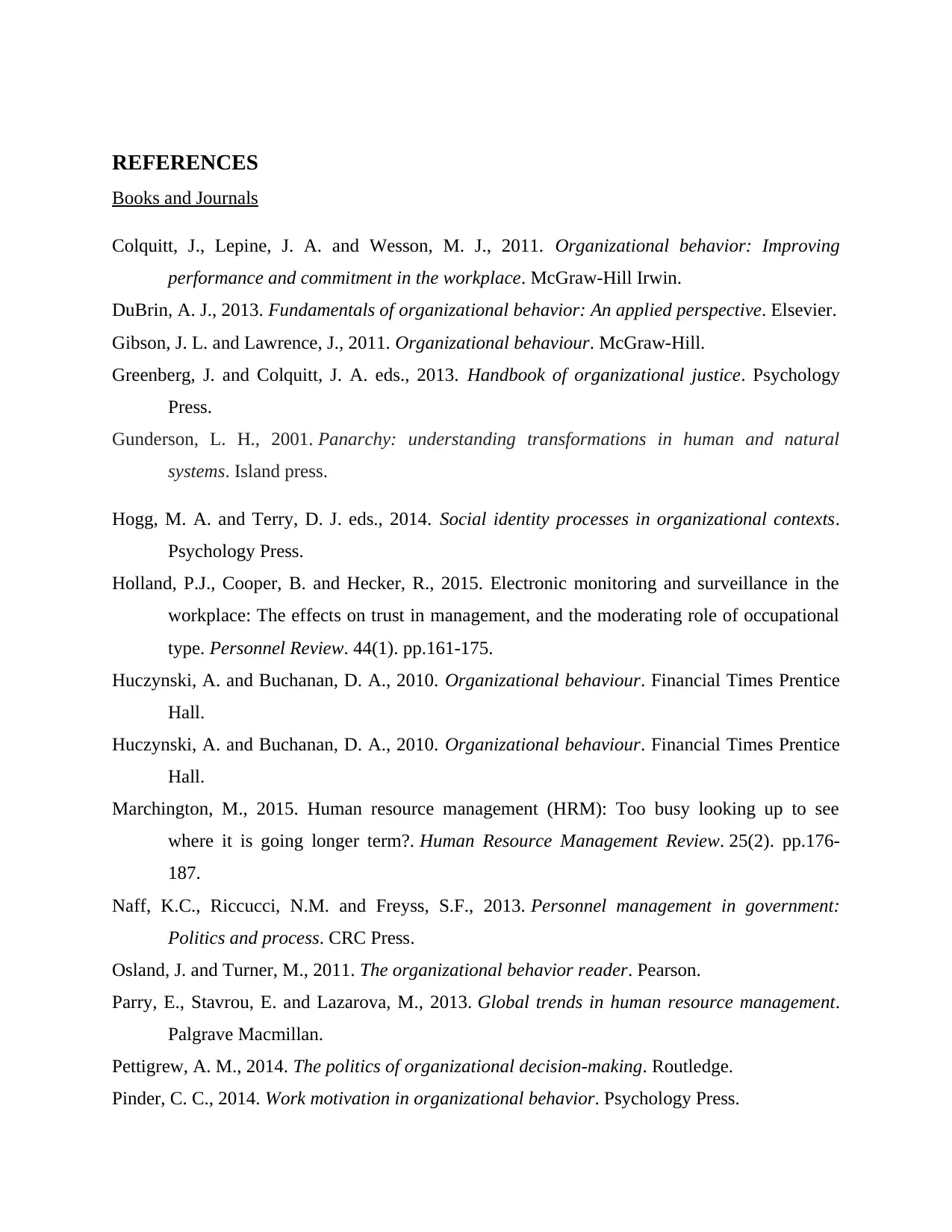
REFERENCES
Books and Journals
Colquitt, J., Lepine, J. A. and Wesson, M. J., 2011. Organizational behavior: Improving
performance and commitment in the workplace. McGraw-Hill Irwin.
DuBrin, A. J., 2013. Fundamentals of organizational behavior: An applied perspective. Elsevier.
Gibson, J. L. and Lawrence, J., 2011. Organizational behaviour. McGraw-Hill.
Greenberg, J. and Colquitt, J. A. eds., 2013. Handbook of organizational justice. Psychology
Press.
Gunderson, L. H., 2001. Panarchy: understanding transformations in human and natural
systems. Island press.
Hogg, M. A. and Terry, D. J. eds., 2014. Social identity processes in organizational contexts.
Psychology Press.
Holland, P.J., Cooper, B. and Hecker, R., 2015. Electronic monitoring and surveillance in the
workplace: The effects on trust in management, and the moderating role of occupational
type. Personnel Review. 44(1). pp.161-175.
Huczynski, A. and Buchanan, D. A., 2010. Organizational behaviour. Financial Times Prentice
Hall.
Huczynski, A. and Buchanan, D. A., 2010. Organizational behaviour. Financial Times Prentice
Hall.
Marchington, M., 2015. Human resource management (HRM): Too busy looking up to see
where it is going longer term?. Human Resource Management Review. 25(2). pp.176-
187.
Naff, K.C., Riccucci, N.M. and Freyss, S.F., 2013. Personnel management in government:
Politics and process. CRC Press.
Osland, J. and Turner, M., 2011. The organizational behavior reader. Pearson.
Parry, E., Stavrou, E. and Lazarova, M., 2013. Global trends in human resource management.
Palgrave Macmillan.
Pettigrew, A. M., 2014. The politics of organizational decision-making. Routledge.
Pinder, C. C., 2014. Work motivation in organizational behavior. Psychology Press.
Books and Journals
Colquitt, J., Lepine, J. A. and Wesson, M. J., 2011. Organizational behavior: Improving
performance and commitment in the workplace. McGraw-Hill Irwin.
DuBrin, A. J., 2013. Fundamentals of organizational behavior: An applied perspective. Elsevier.
Gibson, J. L. and Lawrence, J., 2011. Organizational behaviour. McGraw-Hill.
Greenberg, J. and Colquitt, J. A. eds., 2013. Handbook of organizational justice. Psychology
Press.
Gunderson, L. H., 2001. Panarchy: understanding transformations in human and natural
systems. Island press.
Hogg, M. A. and Terry, D. J. eds., 2014. Social identity processes in organizational contexts.
Psychology Press.
Holland, P.J., Cooper, B. and Hecker, R., 2015. Electronic monitoring and surveillance in the
workplace: The effects on trust in management, and the moderating role of occupational
type. Personnel Review. 44(1). pp.161-175.
Huczynski, A. and Buchanan, D. A., 2010. Organizational behaviour. Financial Times Prentice
Hall.
Huczynski, A. and Buchanan, D. A., 2010. Organizational behaviour. Financial Times Prentice
Hall.
Marchington, M., 2015. Human resource management (HRM): Too busy looking up to see
where it is going longer term?. Human Resource Management Review. 25(2). pp.176-
187.
Naff, K.C., Riccucci, N.M. and Freyss, S.F., 2013. Personnel management in government:
Politics and process. CRC Press.
Osland, J. and Turner, M., 2011. The organizational behavior reader. Pearson.
Parry, E., Stavrou, E. and Lazarova, M., 2013. Global trends in human resource management.
Palgrave Macmillan.
Pettigrew, A. M., 2014. The politics of organizational decision-making. Routledge.
Pinder, C. C., 2014. Work motivation in organizational behavior. Psychology Press.
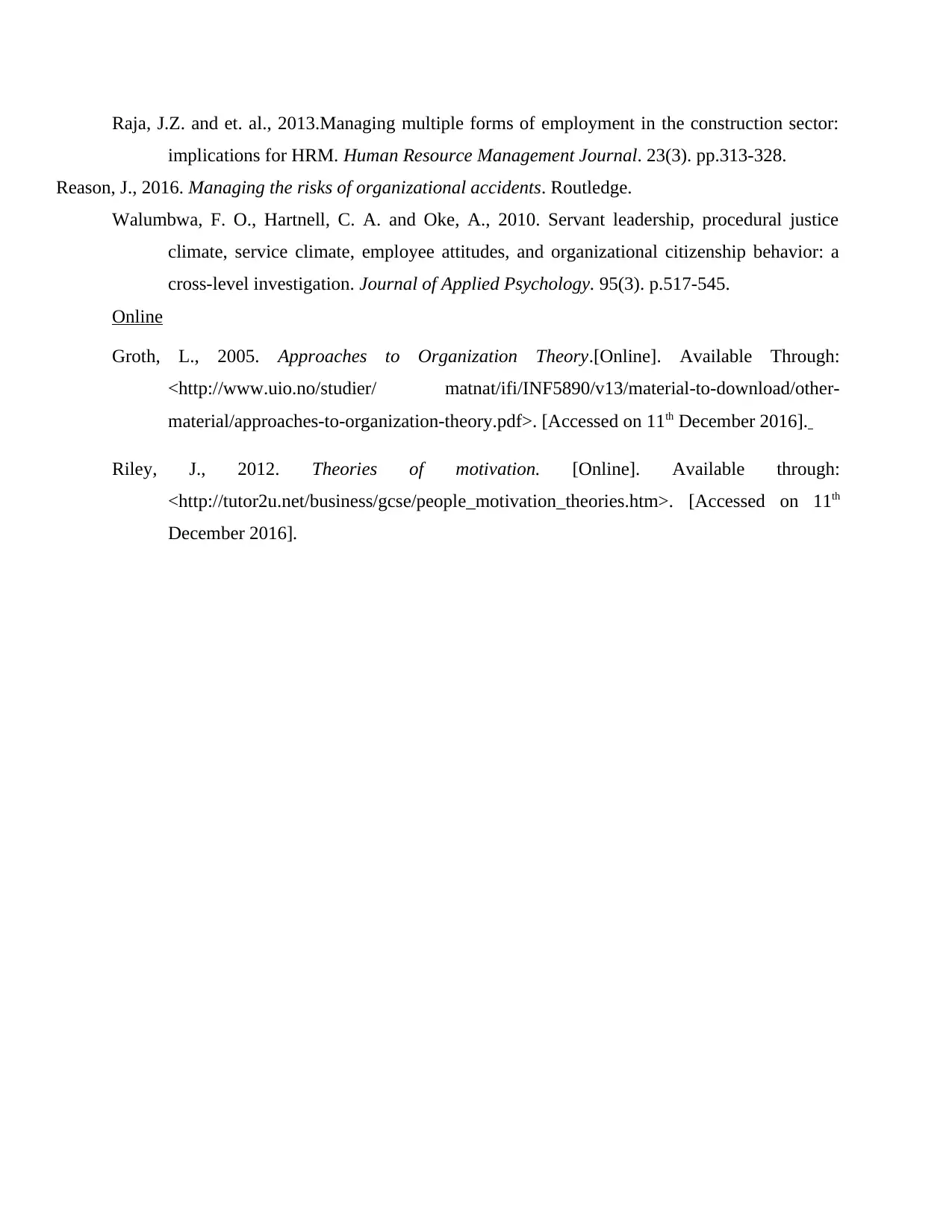
Raja, J.Z. and et. al., 2013.Managing multiple forms of employment in the construction sector:
implications for HRM. Human Resource Management Journal. 23(3). pp.313-328.
Reason, J., 2016. Managing the risks of organizational accidents. Routledge.
Walumbwa, F. O., Hartnell, C. A. and Oke, A., 2010. Servant leadership, procedural justice
climate, service climate, employee attitudes, and organizational citizenship behavior: a
cross-level investigation. Journal of Applied Psychology. 95(3). p.517-545.
Online
Groth, L., 2005. Approaches to Organization Theory.[Online]. Available Through:
<http://www.uio.no/studier/ matnat/ifi/INF5890/v13/material-to-download/other-
material/approaches-to-organization-theory.pdf>. [Accessed on 11th December 2016].
Riley, J., 2012. Theories of motivation. [Online]. Available through:
<http://tutor2u.net/business/gcse/people_motivation_theories.htm>. [Accessed on 11th
December 2016].
implications for HRM. Human Resource Management Journal. 23(3). pp.313-328.
Reason, J., 2016. Managing the risks of organizational accidents. Routledge.
Walumbwa, F. O., Hartnell, C. A. and Oke, A., 2010. Servant leadership, procedural justice
climate, service climate, employee attitudes, and organizational citizenship behavior: a
cross-level investigation. Journal of Applied Psychology. 95(3). p.517-545.
Online
Groth, L., 2005. Approaches to Organization Theory.[Online]. Available Through:
<http://www.uio.no/studier/ matnat/ifi/INF5890/v13/material-to-download/other-
material/approaches-to-organization-theory.pdf>. [Accessed on 11th December 2016].
Riley, J., 2012. Theories of motivation. [Online]. Available through:
<http://tutor2u.net/business/gcse/people_motivation_theories.htm>. [Accessed on 11th
December 2016].
1 out of 13
Related Documents
Your All-in-One AI-Powered Toolkit for Academic Success.
+13062052269
info@desklib.com
Available 24*7 on WhatsApp / Email
![[object Object]](/_next/static/media/star-bottom.7253800d.svg)
Unlock your academic potential
© 2024 | Zucol Services PVT LTD | All rights reserved.





